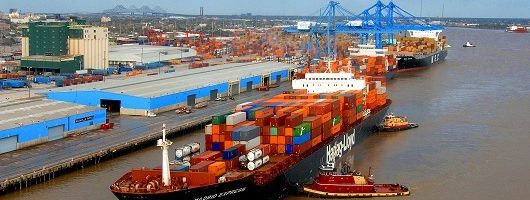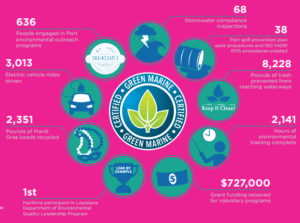Big Nightmare for the Big Easy: The Effect of Climate Change on the Port of New Orleans

Rising sea levels and more frequent and severe storms resulting from climate change are threatening the integrity and existence of our nation’s coastal land and infrastructure – and the Port of New Orleans is no exception.
Following the devastation caused by Hurricane Katrina in 2005, New Orleans captured the nation’s attention as it dealt with the far-reaching impacts of the deadly storm. Outside of the human error involved in the faulty engineering of New Orleans’ failed levee system, one of the primary focus items was the future vulnerabilities that would continue to plague the city’s infrastructure due to shifting climate activity.
Rising sea levels and more frequent and severe storms resulting from climate change are existential threats to our nation at large, but the danger is especially acute for our country’s ports, particularly those in the Gulf Coast area. The Port of New Orleans (“Port”), located at the mouth of the Mississippi River and on the Gulf of Mexico, is the 16th largest port in the U.S. by cargo capacity [1] and a major facilitator of the transportation of the nation’s imports and exports. Given its critical importance to the U.S. economy and domestic and international supply chains, the Port must actively prepare for the impact climate change will have on its operations in the years to come. According to the U.S. Environmental Protection Agency (“EPA”) [2], the number of risks ports face related to climate change include, but are not limited to:
- Changes in Water Levels
- Stronger and More Frequent Storm Events
- The Port is vulnerable to river floods that shut down traffic on the Mississippi River and delay shipping operations [3]
- Stronger wave action, more intense winds and higher storm surges can severely damage the structural integrity of bridges, wharfs, and piers, terminal buildings, ships, and cargo [2]
- Increased precipitation could result in amplified erosion and buildup of underwater silt, potentially decreasing channel depth [2]
- The loss of coastal lands, which serve as critical hurricane and storm buffers, further accelerates the impact of storm activities [2]
Port authorities struggle with how to address these concerns, given the uncertainty of timing and scale associated with climate change. In the near and medium term, the Port is responding to the threat of climate change by examining its own contribution to the problem. The Port is participating in the “Resilient New Orleans” climate change strategy, which, spearheaded by the Mayor’s office, aspires to reduce the city’s annual greenhouse gas pollution by 50% by 2030 [4]. According to the Mayor’s office, “the [Port recently calculated its own greenhouse gas emissions inventory… [and] has also been increasing operational efficiency and reducing its environmental impact through a voluntary program called Green Marine and a clean-diesel program with the EPA.” [4] Additionally, the Port system is working with the State of Louisiana’s Coastal Master Plan to address accelerating rates of coastal land loss, which eliminates much of the natural storm protections from which the Port currently benefits.” [4]
Figure 1: Port of New Orleans’ Participation in the EPA’s Green Marine Program to Date [4]
While it is commendable that the Port is working towards minimizing its own contribution to the overall climate change problem, the organization must take a more active approach to adapting its operations for changes that are already inevitable. Studies show that over the next 15 years, higher sea levels combined with storm surge will likely increase the average annual cost of coastal storms along the Eastern Seaboard and the Gulf of Mexico by $2.0 – $3.5 billion. [5] In an effort to mitigate these costs and protect the current operations of the Port system, I recommend the Port take the following steps in the near to medium term:
- Form an internal working group to focus on climate change adaptation and develop strategic plans for capital improvements
- Construct a protective sea wall beyond the natural coastal protections to shield the coastal land and Port infrastructure from the impact of increased storm surge
- Raise current docks, terminals and warehouses to heights that satisfy scientific predictions of the expected sea level rise within the next 50 years (may need another project at that time)
Of course, it is easy to suggest what may seem like obvious action items, but then the resulting questions become: how will the Port fund these capital-intensive solutions? Will the residents of Louisiana be amenable to increasing their tax burden to help pay for the protection of the Port? Can the Port expect any involvement or support from their business partners in these expensive efforts? (Word Count: 747)
[1] “NAFTA Region Container Traffic 2016 Port Ranking by TEUs”, American Association of Port Authorities, http://aapa.files.cms-plus.com/Statistics/NAFTA%20REGION%20CONTAINER%20 TRAFFIC% 20PORT%20RANKING%202016_T3.pdf, accessed November 2017.
[2] “Planning for Climate Change Impacts at U.S. Ports”, United States Environmental Protection Agency, https://archive.epa.gov/sectors/web/pdf/ports-planing-for-cci-white-paper.pdf, July 2008.
[3] “What Climate Change Means for Louisiana”, United States Environmental Protection Agency, https://19january2017snapshot.epa.gov/sites/production/files/2016-09/documents/climate-change-la.pdf, August 2016.
[4] “Climate Action for a Resilient New Orleans”, City of New Orleans, https://www.nola.gov/nola/media/ Climate-Action/Climate-Action-for-a-Resilient-New-Orleans.pdf, July 2017.
[5] “Risky Business: The Economic Risks of Climate Change in the United States”. Risky Business Project, page 3, June 2014.




Interesting article,
My firm owned a number of ports around the world and preparing for extreme events was always a consideration. To avoid diverting taxpayer money to pay for capital expenditures, they may consider privatization that should give the city a boost to its finances and potentially additional tax revenues.
It will be interesting to see if climate change puts higher capex ports out of business as larger, climate-resistant ports benefit from increased cost advantages and the concentration of supply chains.
The financial burden of capital improvements will surely be a challenge, but hopefully New Orleans can get it right and serve as a model for other port cities likely to face the same situation. In addition to the sea wall, it would be interesting to investigate what role dredging and land reclamation might play in counteracting coastal recession and hedging against extreme weather. Land reclamation has been widely used for other purposes across the globe (Dubai, Hong Kong, Jakarta, etc) but there may be potential for its use in environmental protection. Perhaps “reclaimed” land could even be used from construction and development projects in other parts of the country as part of a sustainable re-use program.
It is interesting to see that how the New Orleans Port could work on reducing the effects from climate change. However, it seems that some of the implications of climate change would be very difficult to deal with such as storms in the Gulf of Mexico. It would be interesting to know more about whether volumes are likely to shift to other ports such as Savannah, Georgia to reduce disruptions from these storms. If Savannah or other ports are good substitutes for New Orleans, it may be that proposed investments could reduce the impact of climate change on the port itself, but that they will not yield a good ROI as volume will shift away from New Orleans as the investments are only able to mitigate parts of the problem.
As a lover of New Orleans, reading this post made me sad! In trying to decide how much Louisiana’s tax payers would be willing to pay for the capex outlined in the original post and Graham’s response, I wondered how much of Louisiana’s economy is actually tied to the port. From the Port of New Orleans website: “The Port of New Orleans is committed to continuing its role as Louisiana’s Economic Engine. Maritime activity associated with the Port of New Orleans accounts for 160,500 jobs in Louisiana and is responsible for $8 billion in earnings.” There is also a significant portion of business generated by the cruise industry: “The Ports’ Cruise industry accounts for $399 million in direct spending in Louisiana and 7,548 jobs. In addition, 60 percent of all cruise passengers spend an average of two nights in New Orleans, which accounts for an additional $28 million in spending locally.”
This signals to me that the port is extremely important to the state of Louisiana and drives the economy by more than just income earned directly related to shipping. The taxpayers of the state of Louisiana should have a strong incentive to protect the port and invest in the capex needed to do so. However, to Peter and Hans’ points, I am very concerned that climate change factors outside the port’s control (that make it more dangerous or difficult to pass through the Gulf of Mexico), will make it more cost effective for goods to enter / exit through other ports in the West or Northeast and travel by land within the U.S. This may be more cost effective for the players involved, although poses serious questions to the future health of the economy in Louisiana.
This is something I thought about for other cities not just New Orleans, especially with all the more frequent and stronger natural disasters. I think your analysis on the impact of another major event is thorough and should be taken seriously.I think your recommendations are also quite actionable not only for New Orleans, but also for another city such as New York City.
One major question I have is whether or New Orleans as a city needs to shift away from the being a city so dependent on its port. I think diversifying the industries in New Orleans more would drive major benefit long-term.